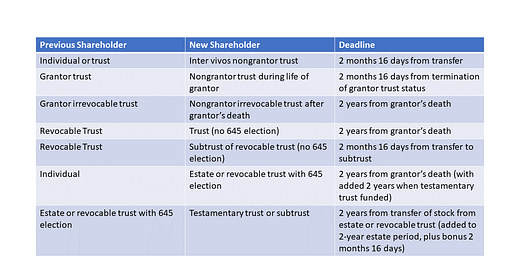C and S Corporations for Estate Planners: the Qualified Subchapter S Trust (QSST)
Examining timing, election mechanics, and structural requirements
This is the eighth installment of C and S corporations for estate planners.
For the prior article in this series, click here.
For the first article in this series and a series index, click here.
Table of Contents
Intro
In the previous article in this series, we introduced the eligible shareholder requirements for an S corporation. Generally, S corporation shareholders must be individual U.S. citizens or residents, and while there are family attribution rules to consolidate shareholder identities, the S corporation cannot have more than 100 shareholders after application of these attribution rules.
Trusts, however, are frequently used in estate planning and can easily become receptacles to hold S corporation stock that is transferred by an individual during life or at death. Since a transfer to an ineligible shareholder can instantly terminate an S corporation election, estate planners must be careful in navigating such transfers. Luckily, there are certain exceptions for trusts.
The prior article mentioned that a wholly-grantor trust (with respect to either the actual grantor, or a beneficiary of the trust) can be an eligible S corporation shareholder because the grantor trust status causes such grantor or beneficiary to be the deemed owner of the S corporation stock in question. Grantor trust status, however, is rarely permanent – especially with respect to the actual grantor of the trust. If and when the grantor dies, we need an alternate method to qualify the trust as an S corporation shareholder.
IRC Section 1361 permits two general trust structures for the holding of S corporation stock on behalf of beneficiaries when grantor trust status does not otherwise apply, whether funded during the grantor’s life or after the grantor’s death. (There is a third permitted structure for voting trusts, but this exception and structure is outside of the scope of our estate planning focus in this series.) The two permitted structures are the qualified subchapter S trust (QSST), and the electing small business trust (ESBT).
This article discusses the technical requirements for a QSST.
QSST Election Timing
Keep reading with a 7-day free trial
Subscribe to State of Estates to keep reading this post and get 7 days of free access to the full post archives.




